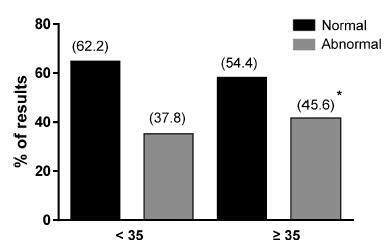-
Original Article03-01-2017
Frequency of Chromosomal Abnormalities in Products of Conception
Revista Brasileira de Ginecologia e Obstetrícia. 2017;39(3):110-114
Abstract
Original ArticleFrequency of Chromosomal Abnormalities in Products of Conception
Revista Brasileira de Ginecologia e Obstetrícia. 2017;39(3):110-114
Views132See moreAbstract
Purpose
To describe the frequencies of chromosomal abnormalities found in abortion material, and to observe its correlation to maternal age.
Methods
A retrospective study was conducted based on data obtained from the databank of a medical genetics laboratory in Belo Horizonte, MG, Brazil. A total of 884 results from products of conception analysis were included, 204 of which were analyzed by cytogenetics, and 680bymolecular biology basedon quantitative fluorescence polymerase chain reaction (QF-PCR). The frequency of individual chromosomal aberrations and the relationship between the presence of anomalies and maternal age were also evaluated.
Results
The conventional cytogenetics technique was able to detect 52% of normal and 48% of abnormal results in the analyzed material. Quantitative fluorescence polymerase chain reaction revealed 60% of normal and 40% of abnormal results from the samples evaluated by this method. The presence of trisomy 15 was detected only by cytogenetics, as it was not included in the QF-PCR routine investigation in the laboratory. A significant increase in abnormal results was observed among women aged 35 years or older compared with younger women (p = 0.02).
Conclusion
Chromosomal aberrations are still a major cause of spontaneous abortion, and the conventional cytogenetics technique is efficient for miscarriage material analysis, but molecular methods such as QF-PCR are adequate complementary strategies to detect the major chromosomal anomalies, leading to technical reports with reliable results.

-
Original Article01-30-2005
Cytogenetic and molecular evaluation of spontaneous abortion samples
Revista Brasileira de Ginecologia e Obstetrícia. 2005;27(9):554-560
Abstract
Original ArticleCytogenetic and molecular evaluation of spontaneous abortion samples
Revista Brasileira de Ginecologia e Obstetrícia. 2005;27(9):554-560
DOI 10.1590/S0100-72032005000900009
Views145PURPOSE: to evaluate the performance of cytogenetic analysis, fluorescent in situ hybridization (FISH) and polymerase chain reaction (PCR) in the study of numerical chromosomal anomalies and in fetal sex determination of spontaneous abortion material. METHODS: cytogenetic analysis was performed on 219 spontaneous abortion specimens. Forty of these cases were also submitted to fetal sex determination using nested-PCR. Thirty-two of these cases were selected due to failed cytogenetic culture and the other eight were selected randomly. Twenty samples were submitted to the FISH technique, using probes for chromosomes 13, 18, 21, X and Y. Thirteen of these samples were selected due to failed cytogenetic culture and the other seven were randomly selected. The success rates of each technique were compared using the chi2 test and an established p<0.05 level of significance. The results of samples submitted to more than one test were evaluated for accuracy, using the cytogenetic result as the gold standard. RESULTS: cytogenetic analysis was successful in 84.9% of the samples and in 51.1% of them the results were abnormal: 65.2% trisomy, 17.9% triploidy, 9.4% tetraploidy, 4.2% chromosome X monosomy, and 1.1% each for double trisomy, tetrasomy and structural abnormality. The most frequent trisomy was that of chromosome 16 (39%). The success rate of FISH and PCR techniques (90%) did nod differ significantly from the cytogenetic analysis. In all cases submitted to more than one test, the results were identical to those obtained through cytogenetic analysis. Samples that failed to grow on cytogenetic test and that were submitted to other techniques of molecular biology had a success rate of 87.5 and 84.6% for PCR and FISH, respectively. CONCLUSION: cytogenetic analysis of spontaneous abortions had a high success rate and chromosomal anomalies were identified in over half of the cases. Molecular biology techniques (PCR and FISH) complemented the cytogenetic study and proved to be reliable in the detection of numerical chromosomal anomalies and in fetal sex determination.
Key-words Abortion, spontaneousCytogeneticsIn situ hybridization, fluorescencePolymerase chain reactionSee more


